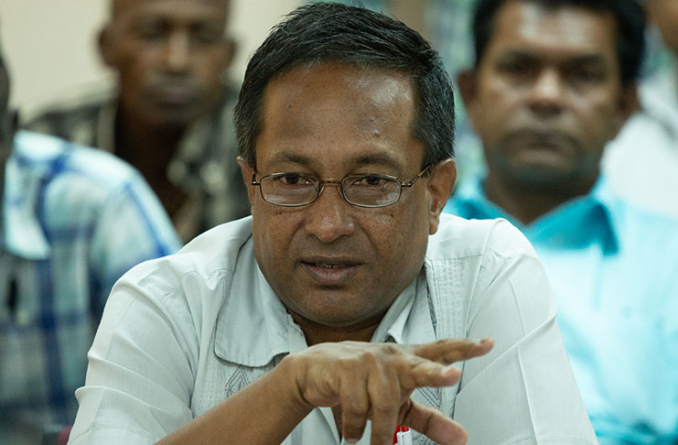The 135-day strike represents one of the proud chronicles of sugar worker activism
Dear Editor,
Mr Earl John in a letter published in the December 20, Stabroek News `More sugar levy history’ sought to give some perspective on the sugar levy. The sugar levy, of course, represents one of the many tangible contributions the sugar industry has made to Guyana and its people.
Mr John in his letter explained the various components of the levy. He shared that the first two of the three components – the Sugar Industry Price Stabilisation Fund and the Sugar Industry Rehabilitation Fund – have been discontinued. The third component – the Sugar Industry Labour Welfare Fund (SILWF) – he mentioned was still in existence though he questioned the wisdom.
Our Union finds this questioning disheartening and that seeming contempt would be directed to the sugar industry funds being utilized to assist the well-being and welfare of sugar workers and their families.
The SILWF which is administered through a Committee which includes representatives of the sugar company, the cane farmers, the Government and the unions has assisted greatly in alleviating the sanitation and infrastructure deficits in sugar communities. We need not forget that it is the sugar workers’ efforts that have allowed the industry to make its manifold contributions to the nation.
The levy, according to the letter writer, was proposed to the then Prime Minister, Forbes Burnham by Bookers Sugar Estates. It is almost unfathomable that a profit-seeking enterprise as Bookers would seek to even initiate any discussion that would seek to tax their “excess profits” as Mr John puts it. Former Labour Minister, Dr N.K. Gopaul, in his book Resistance and Change, pointed out “…Bookers Brothers and McConnell Limited claimed that the 1974 levy imposed by the government was both excessive and punitive and called for its removal.” This appears contradictory to the rosy picture being painted.
Mr John next says that “…it was only in May 1976 that GAWU became the recognised bargaining agent of the sugar workers…”. This, of course, is not correct as GAWU signed the recognition agreement with the Sugar Producers Association on February 27, 1976 and officially was the workers bargaining agent from March 01, 1976.
We are reminded of the 135-day strike by sugar workers in 1977 regarding outstanding profit sharing to sugar workers. The GAWU in a statement in 1977 at the beginning of the strike reminded “the workers have not yet received profit-sharing for the years 1975 and 1976 and were short paid their profit share for 1974”. The union then quantified the benefit owed to sugar workers at G$215 million (US$85 million at that time) and claimed this amount from the GuySuCo.
Of course, Mr John failed to mention that during that period of our history, the then PNC Government moved swiftly to put pressure on protest actions by the sugar workers. Just a week following the strike call, a meeting of the National Assembly was hastily summoned to pass two bills the Summary Jurisdiction (Appeals) (Amendment) Bill and another to reactivate Part II of the National Security Act.
The haste with which the government brought two repressive bills before the National Assembly on September 01, 1977 was indeed alarming, since it suspended the standing rules, and rushed them through all stages, negating the rights of opposition members to have time to consider and examine them in detail.
The result was that the two pieces of legislation gave the Government the right to cancel the basic rights of the people enshrined in both the constitution of Guyana and the United Nations Declaration on Human Rights. This laid the basis for intimidating and coercive actions to be taken against sugar workers and many were incarcerated for frivolous reasons.
The strike was marked by widespread police harassment. More than 130 activists of GAWU and the PPP were arrested on flimsy excuses and most of them were charged for intimidation. Incidents of police harassment were numerous. One striker, Lokie Narine of Blairmont, was charged for “public terror”. After five weeks in prison, he was put on bail for $10,000. In many cases bail had been excessive, from $5,000 to $12,000 for simple offences.
In West Berbice, Mansaran Persaud and S. Sakichand were arrested and, after being held for 36 hours, each was placed on bail of $1,000 (cash) or $2,000 (transport) and ordered to report once every week to the police station even though they were not charged with any offence.
In West Demerara, one cane scale representative, Goolgar, was arrested four times. A GAWU field secretary, Jeewan Persaud, was arrested, held for 24 hours, released and re arrested as soon as he exited the police station.
Two workers on strike, Amernauth and S. Prem of Blairmont, on a charge of intimidation, were granted bail at $5,000 (each) or $10,000 (transport) on the condition that they give a verbal assurance to the magistrate that they would return to work. A GAWU motor car was impounded at the New Amsterdam police station on three occasions within six weeks, two times for “fitness”, and the third on October 13, for suspicion of having stolen parts.
These actions were of sheer malice against the Union since the police were fully aware that the vehicle was being used by the GAWU and its Honorary President and Leader of the PPP, Dr Cheddi Jagan.
Also, a van load of food for striking workers in West Demerara was seized by the police. Three separate quantities of foodstuff for workers on strike were also seized in New Amsterdam and East Berbice as well as 39 bags of rice at Enmore.
These actions evidently formed the basis of the punitive action the then government had in mind. Moreover, the Government, conveniently, then declared that the strike was political so as to enable it to embark on total counter-mobilisation.
In a joint statement of January 07, 1978, the CCWU, the UGSA and the NAACIE said “[t]he methods used to bust the strike – arrest and prosecution of organisers, excessive bail, the banning of public meetings, the seizure of strike relief, the use of military and para military forces, as well public servants, to do the work of the strikers and the mass recruitment and use of scab labour including child labour, from the ranks of the unemployed – recall the worst anti-labour practices of the capitalist bosses … When all these is added the threat of detention without trial and of curfew under Part Two of the National Security Act, it is clear that we fight against a type of neo-colonial barbarism…”
Mr John also spoke about two unionists from the United Kingdom visiting during the workers strike action. The unionists were representatives of the workers of Tate and Lyle in London and notably the workers there refused to unload Guyana’s sugar.
According to the letter writer the unionists “…recommended against the blockade.” However, Dr Gopaul recorded “…[t]wo shop stewards from Tate and Lyle refinery in UK, Terry Hardy and John Wheatley, visited Guyana and informed the Guyanese public on their effective blockade of Guyana’s sugar at ports in the UK in solidarity with the striking sugar workers.
Their presence in Guyana forced an admission from the government, which had previously denied press reports that ships with sugar from Guyana were held in UK ports without being discharged.” Again it appears; Mr John has his history mixed-up.
Of course, even the TUC then recognized that the Government perpetuated the strike. Then General Secretary of the TUC, Joseph Pollydore, in a letter of November 02, 1977 to the Minister of Labour pointed out “[t]he workers never anticipated that they would witness… a nationalised industry… in a much stronger position than the industry had been under capitalist ownership, to show resistance to the acceptance of traditional terms of resumption and be allowed to remain steadfast… while the country’s economy suffers enormously.”
The strike represents one of the proud chronicles of sugar worker activism and struggle and the hurdles they have to jump through to be respected and treated with dignity. Today, we see again a similar contemptuous attitude taken by the heirs of then then Government.
Yours faithfully,
Seepaul Narine
General Secretary,
GAWU






















